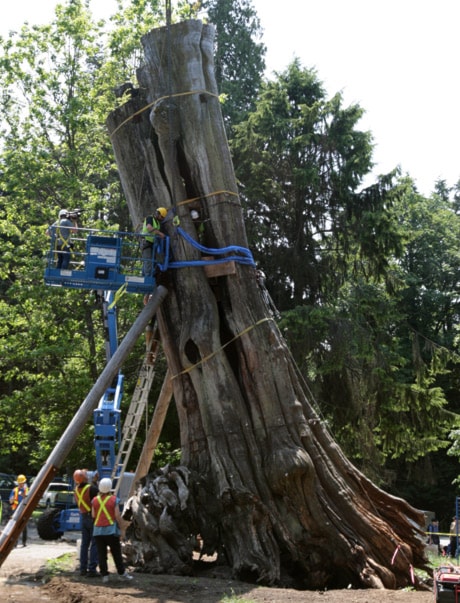VANCOUVER — One can’t help but think of all those who have walked this way before, along the paths, forests and lawns of Stanley Park, in search of the famous 1,000-year-old Hollow Tree.
After all, the giant red cedar has been a Canadian tourist attraction for more than a century, attracting sightseers since before the Silver Dart made the first powered flight through Canadian airspace, before Lucy Maud Montgomery published Anne of Avonlea and even before Sir Wilfrid Laurier became prime minister.
Defenders of the 13-metre-tall stump, along Stanley’s Park Drive and once leaning more than that famous tower in Pisa, have managed to save the stately old tree from demolition.
A work crew has begun the $200,000-job of straightening and anchoring the decomposing tree, in what for some is a happy ending, for others an outrageous waste of money.
Ten thousand living trees were knocked down in a fearsome storm that roared through Stanley Park in December 2006. And this cavernous old stump is far from the only hollow tree on the grounds of the 1,300-hectare park.
But it’s a storied tree and one that became iconic in the way other dead wood did not, after the sheer enormity of the tree’s cavity was put in perspective in Victorian times by a horse-drawn carriage carrying a half-dozen tourists photographed in its belly.
Still, Vancouver’s Park Board voted last April to cut down the tree, fearing it would collapse on modern-day tourists who might walk the sprawling park’s grounds to take it in. It got a life line when volunteers raised money from donations to keep it upright.
Visitors must decide for themselves whether it is worth the 90-minute hike from the park’s Georgia Street entrance to view the Hollow Tree.
There are many along the route who will tell you it is not.
“I think you’ll be disappointed,” says one Vancouverite, who walks the park’s winding trails regularly, when asked for directions from Lake Trail.
Even one of the park’s ground keepers seems uncomfortable when asked again where the celebrated tree can be found. She looks embarrassed, as though the tree’s diminished state was the park’s dirty little secret.
“I don’t know if it’s what you’re expecting,” she says, a little flush colouring her cheeks red.
Indeed, on first sight, the bright blue chainlink fence that kept onlookers at a distance and the wooden cable poles that propped it up would make anyone with any affection for the Hollow Tree want to look away.
After the initial surprise that 100 years later it does not look like it did in the old black and white photographs, the tree’s trunk — 20 metres around — comes into view. The real disappointment is that one can’t get close enough to it to capture keepsake photos of one’s own.
There are as many opinions about the tree as there are visitors to it.
A sign posted by the Hollow Tree Society declares it “culturally modified” and lists the Top 10 reasons to love it.
Another urged people to “listen! $250,000 for a dead stump? Save your money to pay the extra taxes you’ll be faced with because of the Olympics.”
For our part, standing in front of an icon that has been a beacon for so many years felt like a rare shared moment in history. But it was no more satisfying than breathing deeply the fresh smell of the forest after rainfall or treading on the soft, needle-covered forest floors that entice a visitor off Stanley Park’s paved paths.
The majestic park’s flora and fauna change with each season, bringing something new to every visit. And the formal rose and tulip gardens look like something Monet would be inspired to paint.
As they say, it’s sometimes the journey, not the destination, that leaves the most indelible mark.
———
If you go...
Enter Stanley Park through Georgia Street. Follow the Lagoon Drive to Park Drive, head north until Just past Meadow Trail. Or, ditch the map and just meander along the various trails until you stumble upon it. It’s the longer route, but ultimately more enjoyable.
For donations to the Hollow Tree Conservation Society: www.savethehollowtree.com
